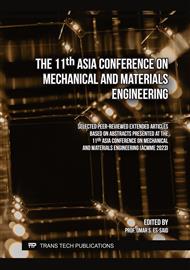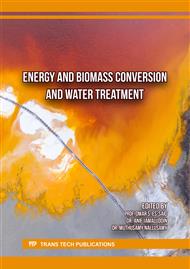p.77
p.83
p.89
p.97
p.105
p.111
p.119
p.129
p.135
A New Green Solvent: Synthesis and Characterization of Natural-Deep-Eutectic-Solvent (NADES) for Application on Aqueous-Two-Phase System (ATPS) for Extraction of Anthocyanin
Abstract:
Anthocyanins are said to possess antidiabetic, anticancer, anti-inflammatory, antimicrobial, and anti-obesity effects. There is lot of emphasis placed on the improvement of the methods for extracting anthocyanins; one of which being extraction via aqueous two-phase systems (ATPS). Aqueous two-phase system is a liquid-liquid extraction method that has many benefits like easy to scale up with high recovery yield. However, ATPS also has drawbacks as it utilizes organic solvents and low biodegradability ionic liquid. In this context, Natural Deep Eutectic Solvents (NADESs) which are inexpensive, eco-friendly can be employed in aqueous two-phase system. Thus, the purpose of this research is to explore the feasibility of NADES-ATPS in the extraction and purification of anthocyanins. This research will investigate the solubility of anthocyanins and characterize the NADESs in terms of density, viscosity, and polarity to screen out NADESs that are suitable to be used for the extraction of anthocyanins. To do this, 6 different types of NADES with different molar ration, such as 1:1,1:2 and 1:3 of hydrogen bond acceptor (HBA) to hydrogen bond donor (HBD) ratio, were prepared and screened. The NADES was prepared using choline chloride as HBA, and malonic acid, lactic acid, glycerol, ascorbic acid, urea, and citric acid as HBD. The solubility of 10% anthocyanin was found in a range of 0.60×10−2 g/g to 1.81×10−2g/g. The solubility of the anthocyanins in NADES was correlated to the viscosity and polarity of the NADES where it was seen that the solubility has a positive relationship with polarity. The solubility also showed a similar trend to the viscosity however up to critical point, upon which the solvent was too viscous and was unable to be utilized in room temperature. The research concludes that malonic acid-based NADES to be the most suitable to be utilized for the extraction of anthocyanin using ATPS.
Info:
Periodical:
Pages:
105-110
Citation:
Online since:
December 2023
Price:
Сopyright:
© 2023 Trans Tech Publications Ltd. All Rights Reserved
Share:
Citation:



